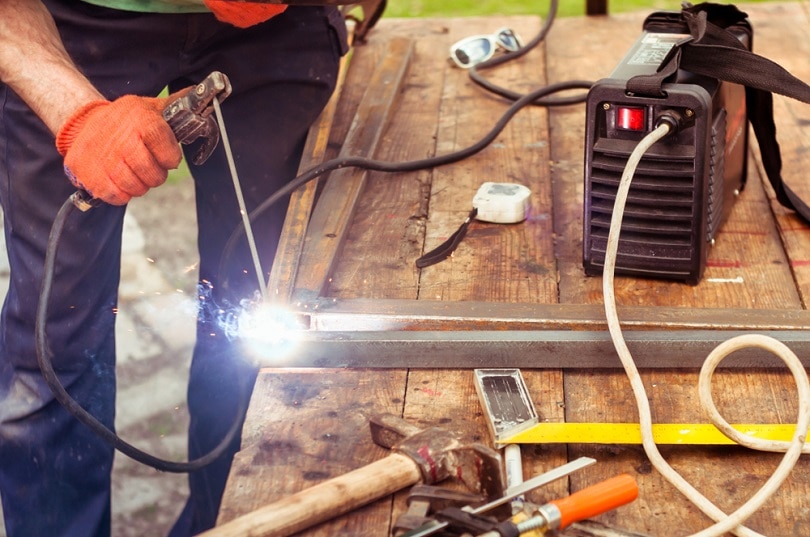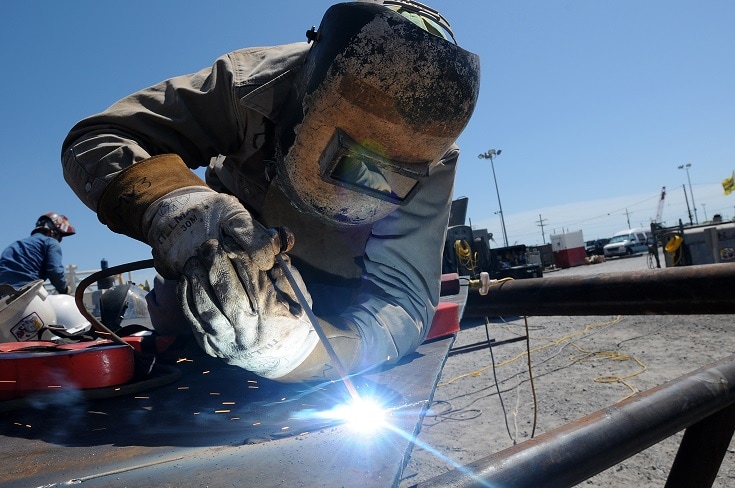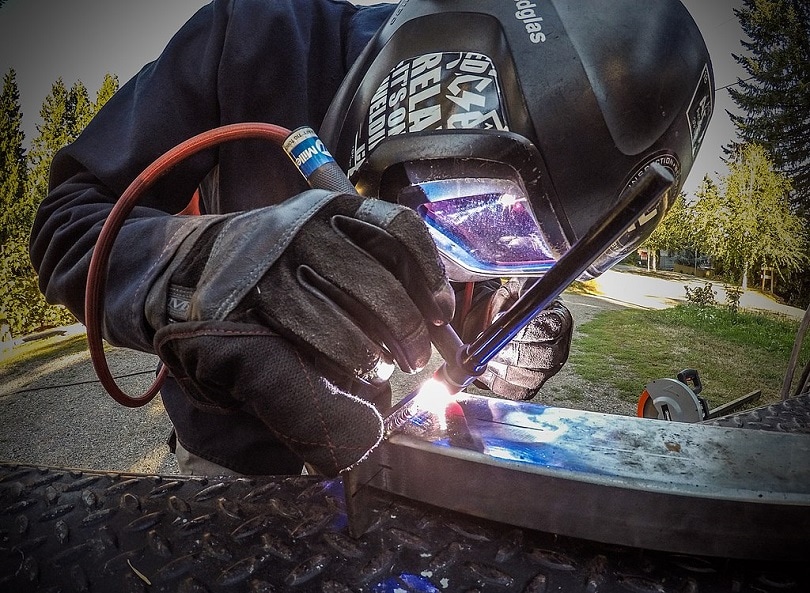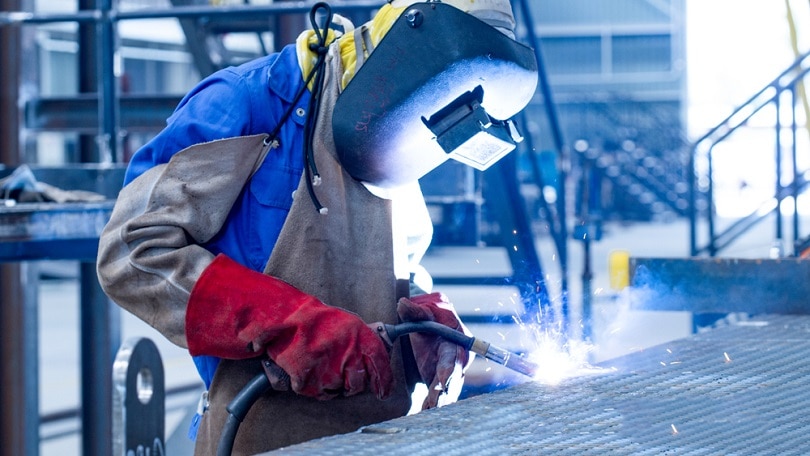What is Duty Cycle in Welding and How is it Calculated?
Last Updated on

Duty cycle refers to the period you can run your welding machine at the recommended amperage. It is usually measured in ten minutes. For example, at 200 amps with a 30% duty cycle, you can run the welding machine for 10 minutes. In the first 3 minutes, run the machine continuously while maintaining 200 amps. In the remaining 7 minutes, the machine automatically switches to thermal overload to cool down.
How Does It Work?
A machine’s duty cycle changes at different amperages. When the machine operates at higher amperage output, it will heat more quickly while the duty cycle tends to reduce. Conversely, the duty cycle increases when the machine runs at lower amperages.
The basic formula of computing duty is always the same. However, several factors can determine the result of a duty cycle test. Below are the factors.
- Ambient temperature in which the test was conducted: A higher ambient temperature can be more demanding.
- The time frame over when measurements were taken: Experts recommend between five and ten minutes.
- The machine’s condition: Was the testing done on a cold machine or an already heated machine and ready for prolonged use? Moreover, testing on an already heated machine is much more demanding on its cooling system.
The widely accepted standard for testing to determine the duty cycle rating is the European Standard EN60974-1. Additionally, the European Standard provides the base from which the Australian Standard AS609974-1 was established. These standards are considered the best to determine and show how a machine performs in a real-life setup.
To rate a duty cycle of a machine running at a rate of 200A at 30%, using the European standard EN60974-1, below are the steps.
- First, heat the machine to the appropriate temperature by continuously welding and ensuring it cuts out twice on the thermal overload.
- Conduct the test in a controlled chamber heated to 104 degrees Fahrenheit (40 degrees Celsius) and allow the machine to weld at 200 amps for a total of 3 minutes over a 10 minutes interval. Thus, the duty cycle of 200A at 30%.

How to Calculate Duty Cycle
The duty cycle is computed as follows:
D = (PW/T) * 100%
D refers to the duty cycle.
PW refers to the pulse width, usually when the pulse on or busy.
T refers to the total period of the signal.
Whenever a digital signal consumes half of the time when it is powered ON, and the other half switched OFF, its digital signal has a duty cycle of 50%. If the percentage of the duty cycle is higher than 50%, the digital signal is spending more time on the upper state than on the lower state. However, the higher the duty cycle percentage, the better the system will operate.
What are the Different Types of Duty Cycles?
- Continuous Duty (S1 duty): It is the first and most straightforward type of duty cycle. With this operation, the machine’s motor runs for an extended period before reaching its thermal equilibrium. In S1 duty, the period when the machine is powered will have a significant impact on when determining its temperature.
- Short Time Duty (S2 duty): Abbreviated as S2 and accompanied by the number of minutes in the duty cycle (S2 30 minutes). Its operation is similar to that of S1. However, the operation in S2 is usually shut off before reaching its equilibrium. Additionally, cooling of the machine in S2 usually takes a more extended period.
- Periodic Duty (S3-S8): This category covers all duty cycles between S3-S8 regardless of whether they have breaks or no brakes. This category also focuses on issues such as starting, electric braking, and swapping loads during breaks. Notably, several of these duty cycle operations are replicated during all the categories between S3- S8. In this category, the machine is not allowed to reach its thermal equilibrium.
There are two duty cycles under the periodic duty:
- Intermittent periodic duty(S3)
- Continuous operation with electric braking( S7)

Intermittent Periodic Duty (S3): Here, operations are categorized in identical cycles, each bearing a session of rest and a period of constant load. Moreover, this duty cycle is abbreviated as S3, accompanied by the percentage of time under load (S3 30%).
Continuous Operation with Electric Braking (S7): This duty cycle comprises starting, regular load, and electric braking. Besides, the operation does not have a resting time in between the series.
Where is Duty Cycle Used?
Duty Cycle and MIG Welding
MIG welding involve automated processes. MIG welds are designed with state of the art duty cycles that enable operators to weld for prolonged sessions. Welders get to enjoy uninterrupted timelines between the welds giving them the ability to work on large orders. However, this varies with different applications.
A good example where the duty cycle is critical can be in a production set-up, where jigs are used to cut on set up and capitalize on welding time. You can also use a welder with a bigger capacity to work uninterruptedly.
Duty Cycle and MMA/Stick Welding
MMA/Stick welding is more of a manual process that involves alternating aspects like chipping slags and electrodes. The portion of time an operator spends on welding is less compared to MIG since MMA involves manual processes. For this reason, the duty cycle is not as important as that of the MIG.
A machine in the Weld class range with a 140amps maximum output is considered the smallest MMA/Stick. However, with a duty cycle of 100Ampls at 60%, it will have sufficient power to run a standard 2.6mm electrodes non-stop. It can also run a 3.2mm electrode smoothly.
Duty Cycle and TIG Welding

In TIG welding, the importance of the duty cycle varies considerably. Furthermore, TIG is generally applied to detailed work, especially on thinner materials or smaller parts. Moreover, to add icing on the cake, on TIG, the machine may never come close to attaining its duty cycle limit.
Moreover, the machine can do loads of welding with low amperage at a duty cycle of 100%. Since TIG is a manual process involving feeding the filler metal by hand, the welding or the on-time ratio and off-time are lower than that of MIG. Some of the TIG applications in which a high duty cycle is necessary include the TIG welding of pipe joints. Such applications will require long and continuous wielding.
The Advantages of Duty Cycle in Welding
Prevent fire accidents: Once the machine has reached the maximum temperature of its duty cycle, the thermal overload protection will automatically be ignited. Once the protection is on, the machine will switch off immediately. With such measures, you will experience more efficiency and productivity in your welds. The end result is high-quality welds and maximization on returns.
Produce high-quality welds: It goes without saying that understanding your machine means making quality products with zero defects.
Prioritizing your welds: Once you have understood your machine’s duty cycle, you can prioritize your welding schedule, like knowing when to stop welding hence meeting all your targets.
Disadvantages of Duty Cycle
Expenses incurred during accidents: Sometimes, the machine can overheat and burst into flames. This could be due to the thermal overload protection failing to trigger once the duty cycle has gone overboard. This may cause severe losses to the operator and can even lead to fatalities.
Constant interruptions during welding: When dealing with critical welds with tight deadlines, the frequent cut-outs may prevent you from meeting the expected targets, potentially causing downtimes. This is rampant in machines with a lower duty cycle.
Poor quality welds: Some machines that always tend to hit the duty cycle limit after a short span of wielding will decrease weld quality.
FAQs
What happens when duty cycle is exceeded?

Whenever the duty cycle reaches its optimal temperature, thermal overload protection is triggered. This will cause the machine to shut down until it cools off for another welding session. Most welding machines are fitted with a thermocouple to sense when the machine is overheating.
Moreover, these welding machines are programmed to prioritize their needs to come first, followed by yours. The machine will therefore limit you from pushing it to the point of meltdown.
How likely is the duty cycle to be a problem?
For a duty cycle to be a problem, it depends on your welding sessions. Some welds require short periods of welding. A good example, during arc welding, the machine will require you to change the electrode. Also, during TIG welding, you will need breaks in between your welding to reposition.
What is a good duty cycle?
A good duty cycle depends on several factors. They include the specific settings applied to the machine, the welder, and the welding process.
For example, in TIG welding, it involves many manual processes, unlike in MIG, where processes are automated. This difference makes the degree of significance of the duty cycle less in TIG compared to MIG.
What are the factors that affect the duty cycle?
The duty cycle is generally affected by several factors. They include voltage, amperage, ventilation, and temperature. When a machine is backed against a wall, the fan produces limited airflow due to the poor ventilation. Without proper airflow, the machine will be heating up quickly and cooling down slowly.
Such discrepancies trigger temperature shifts that greatly affect the duty cycle. Always ensure your working area is well ventilated. This will allow air to circulate freely and allow heat generated by the welder to escape easily.
Final Thoughts
Every welder’s ambition is to have a machine that can leverage their welding work and last longer. Always be mindful of your machine’s duty cycle to prevent losses, accidents, and break downs. Ensure you constantly do a routine check-up and maintenance on your machines to identify faults before they cripple your operations. You can also call in a welding engineer to conduct a professional assessment and do the necessary repairs and replacements. Keep in mind, well-maintained machines result in quality welds!
Featured Image Credit: Per Hortlund, Flickr
